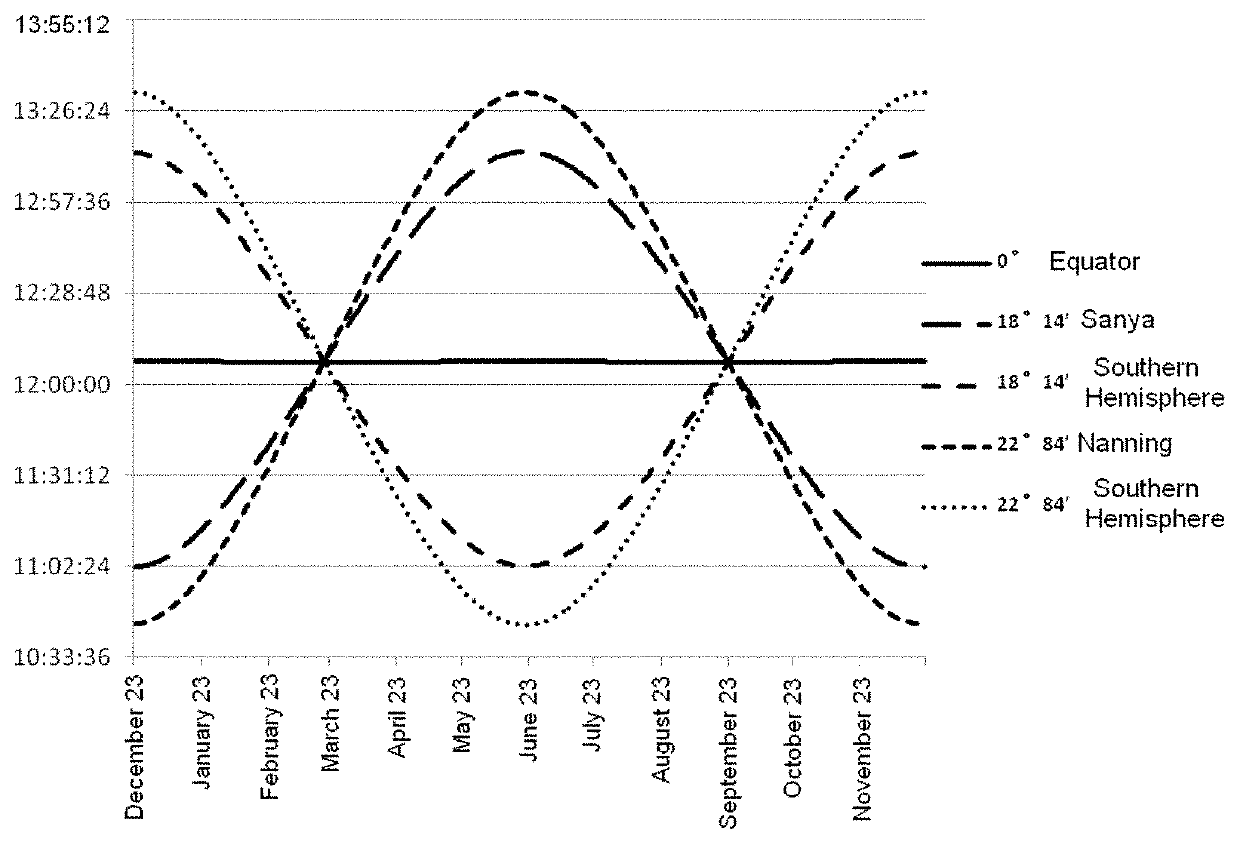Method for breeding new variety of ratoon rice crop and cultivation method for new variety of ratoon rice crop
a technology of ratoon rice and cultivation method, which is applied in the field of plant breeding and cultivation, can solve the problems of low yield, fluctuation of cultivated area, low yield, etc., and achieve the effects of reducing the production cost of rice, reducing the variation in day length, and saving costs and efficiency
- Summary
- Abstract
- Description
- Claims
- Application Information
AI Technical Summary
Benefits of technology
Problems solved by technology
Method used
Image
Examples
example 1 implementation
of the Invention in the Equatorial Region
[0105]The illumination and temperature resources in the equatorial region are abundant, and the day length is relatively stable. The annual day length is between 12 hours and 6 minutes and 12 hours and 7 minutes. The variety with a critical day length shorter than 12 hours and 6 minutes can be screened or bred. For example, a variety with a photosensitivity similar to that of RH. The critical day length of RH is about 11 hours and 28 minutes. The photoperiod induction can be broken by shading treatment. Shaded for 8 to 30 days, and gave 9-10 hours of natural illumination every day. After the completion of the photoperiod induction, turned into natural illumination. After harvest of main crop, by using the key technologies provided by the invention, such as, leaving low stubbles, the no-water layer or a thin-water layer with a water depth not more than 3 cm was maintained within 7 days after harvest of main crop, with the premise that the soil...
example 2 implementation
of the Invention in Sanya, Hainan
[0116]Sanya is located at low latitude and belongs to a tropical maritime monsoon climate zone with abundant illumination and temperature resources. The annual average temperature is 25.7° C., and the month with the lowest temperature is January, with an average of 21.4° C. It is known as the “natural greenhouse”. The day length is the longest on June 21 every year, which is 13 hours and 13 minutes; and the day length is the shortest on December 22 every year, which is 11 hours and 2 minutes. The day time of the whole year is 2534 hours. Rice can be planted on an annual basis.
[0117]The temperature and illumination conditions in Sanya are good, and the sowing time is relatively free. In theory, without considering other factors, there are not less than 20 days with the time longer than the critical day length of a photosensitive variety in Sanya, that is, the critical day length is shorter than 13 hours and 10 minutes (June 11 to July 1). The variety ...
example 3 implementation
of the Invention in Nanning, Guangxi
[0122]Nanning is located on the south side of the Tropic of Cancer and belongs to a humid subtropical monsoon climate. The annual average temperature is about 21.6° C. The extreme maximum temperature is 40.4° C., and the extreme minimum temperature is −2.4° C. The illumination and temperature resources are abundant. A significant difference between Nanning and tropics such as the equator and Sanya is that rice cannot be planted on an annual basis.
[0123]Early rice in Nanning was usually sown at the end of February and harvested at the beginning of July, and the longest day of the year appears on June 21. Due to the limitation of early illumination and temperature conditions, it was suitable to arrange main crop to be harvested generally at the end of June and early July. If the harvest was too early, it was easy to cause the insufficient growth period and low yield of main crop. Ratoon rice was treated with the long-day treatment for not less than ...
PUM
 Login to View More
Login to View More Abstract
Description
Claims
Application Information
 Login to View More
Login to View More - R&D
- Intellectual Property
- Life Sciences
- Materials
- Tech Scout
- Unparalleled Data Quality
- Higher Quality Content
- 60% Fewer Hallucinations
Browse by: Latest US Patents, China's latest patents, Technical Efficacy Thesaurus, Application Domain, Technology Topic, Popular Technical Reports.
© 2025 PatSnap. All rights reserved.Legal|Privacy policy|Modern Slavery Act Transparency Statement|Sitemap|About US| Contact US: help@patsnap.com

